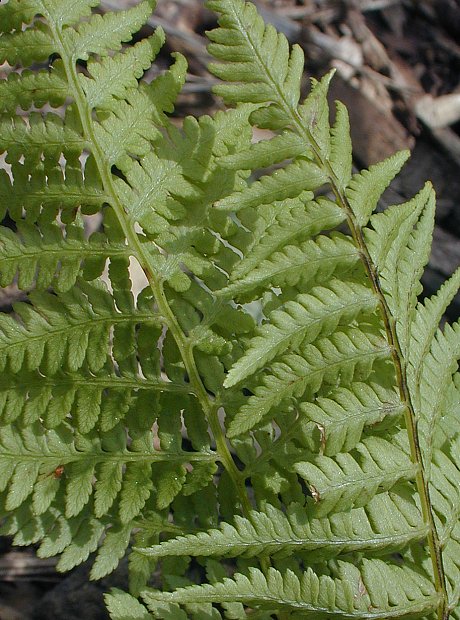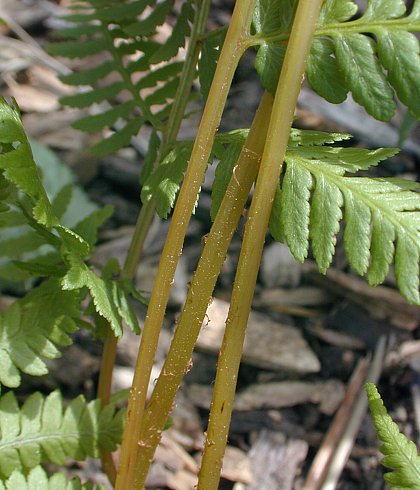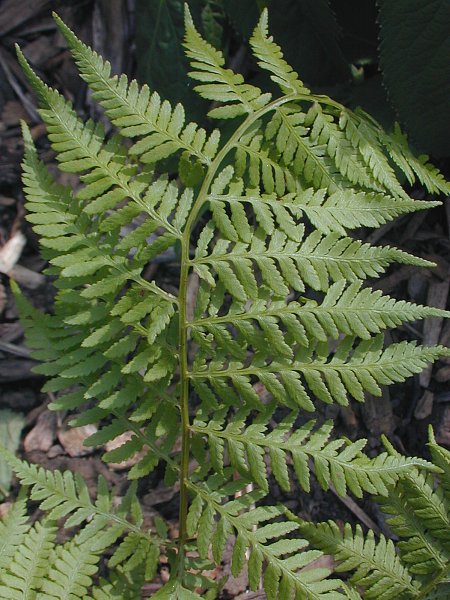Description: This perennial fern is 1-3' tall, forming loose clusters of deciduous leaves that are erect to ascending. The slender petioles are 4-10" long and yellowish green, tan, or brown; sometimes they are softly pubescent or sparsely scaly. The compound leaves are light green or yellowish green, mostly bipinnate-pinnatifid, and about one-third as wide as long. In outline, the compound leaves are lanceolate to lanceolate-ovate; each compound leaf has 15-30 pairs of leaflets along its rachis (central stalk), terminating in a slender pinnatifid tip. The lowermost leaflets are only slightly shorter than the middle leaflets. Individual leaflets are linear-lanceolate to narrowly lanceolate in outline; they are mostly pinnate-pinnatifid with 10-20 pairs of subleaflets, becoming slender and pinnatifid toward their tips.

The subleaflets are short-oblong in outline; they are shallowly cleft and crenate along their margins. The upper surface of each compound leaf is usually hairless, while the lower surface is hairless to softly pubescent. The rachis of the compound leaf is light green to yellowish green, narrowly grooved above, and convex below; it is sometimes softly pubescent below. Along the margins of the subleaflets on their undersides, there are small cup-shaped to cylindrical indusia (protective membranes) containing the sporangia (spore-bearing structures). The shape of an indusium is determined in part by a tooth or lobe of the subleaflet folding underneath itself. The sporangia and indusia develop during the summer or autumn; the spores of the sporangia are distributed by the wind. The root system is rhizomatous and fibrous. This fern often forms clonal colonies from the rhizomes.

Cultivation:
The preference is partial sun to light shade, mesic conditions, and a
somewhat acidic soil containing sandy loam or rocky material. In some
northern areas (e.g., in New England), this fern will grow in open
areas and it can spread aggressively, but in most areas of Illinois
this fern prefers some shade and it is less aggressive. The leaves are
attractive from late spring to mid-summer, but they become more ragged
in appearance later in the year.
Range & Habitat:
The native Hay-Scented Fern is rare in Illinois (see Distribution
Map), which lies along the western range-limit for this
species. In Illinois, habitats are restricted to sandstone
ravines, shaded sandstone cliffs, and thinly wooded bluffs
along rivers. This fern is found in high quality habitats in Illinois,
although in areas further to the east it is often found in disturbed
areas. Sometimes this fern is cultivated in gardens.

Faunal
Associations:
Information about floral-faunal relationships is limited. Two plant
bugs feed on the Hay-Scented Fern: Macrolophus
tenuicornis and Monalocoris
americanus (Wheeler et al., 1983). The latter plant bug
feeds on the sporangia (spore-bearing structures). In woodlands
where White-Tailed Deer are abundant, this fern has a tendency to
increase in abundance because it is not preferred as a food source.
Where sizable colonies of plants are present, this fern provides
significant protective cover for wildlife. Otherwise, its ecological
value to wildlife appears to be low.
Photographic Location:
A garden at the Arboretum of the University of Illinois in Urbana,
Illinois.

Comments: The common name derives from the hay-like scent of the drying leaves during late summer or autumn. This is the only fern of its genus in the Midwest and NE United States. It is unique because the indusia and sporangia are partly covered by the folded marginal teeth and lobes of its leaves. Generally, the Hay-Scented Fern (Dennstaedtia punctilobula) is a lighter shade of green and more lacy in appearance than many other ferns. Compared to the common Fragile Fern (Cystopteris protrusa), it is larger in size and its leaves and leaflets have more slender tips. Compared to the Lady Fern (Athyrium filix-femina), it has more narrow leaves and its spore-bearing structures are located along the margins of its leaves. The lacier wood ferns (Dryopteris spp.) also resemble the Hay-Scented Fern, but their leaves are usually a darker shade of green, they often lack hairs on their petioles and leaves, and the margins of their leaves do not fold over their indusia and sporangia.